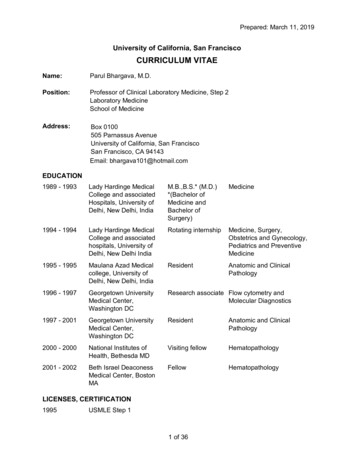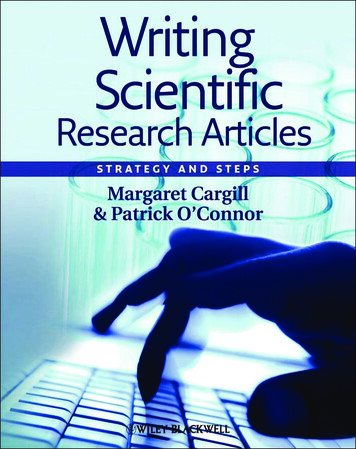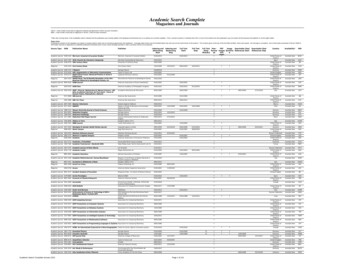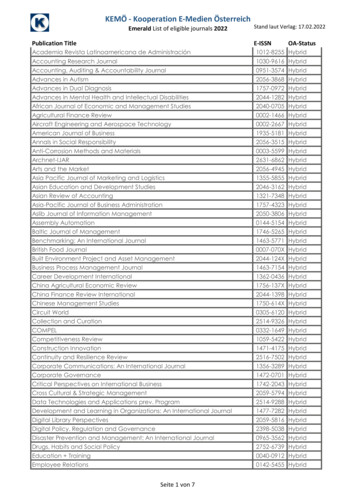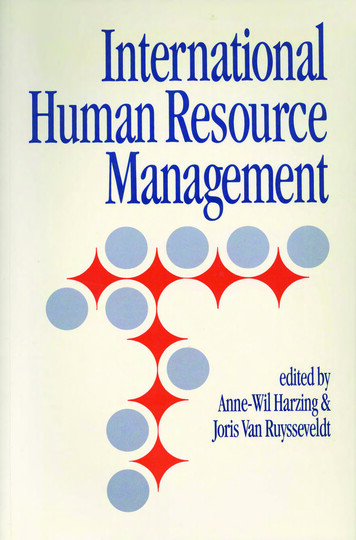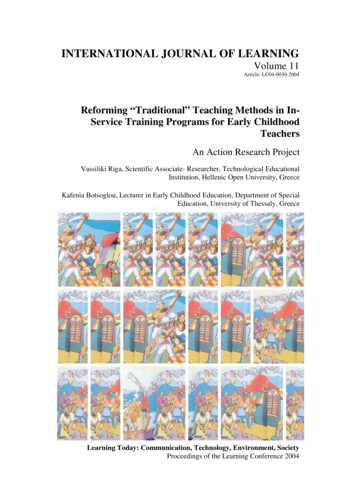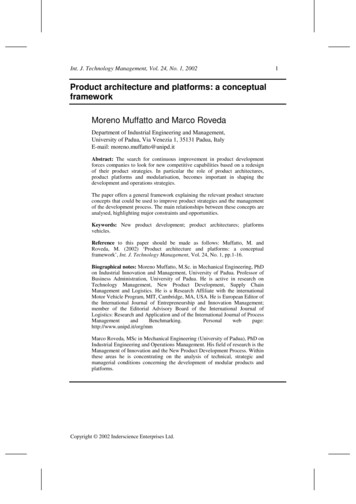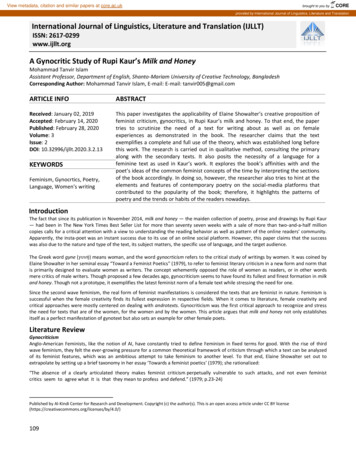
Transcription
View metadata, citation and similar papers at core.ac.ukbrought to you byCOREprovided by International Journal of Linguistics, Literature and TranslationInternational Journal of Linguistics, Literature and Translation (IJLLT)ISSN: 2617-0299www.ijllt.orgA Gynocritic Study of Rupi Kaur’s Milk and HoneyMohammad Tanvir IslamAssistant Professor, Department of English, Shanto-Mariam University of Creative Technology, BangladeshCorresponding Author: Mohammad Tanvir Islam, E-mail: E-mail: tanvir005@gmail.comARTICLE INFOABSTRACTReceived: January 02, 2019Accepted: February 14, 2020Published: February 28, 2020Volume: 3Issue: 2DOI: 10.32996/ijllt.2020.3.2.13This paper investigates the applicability of Elaine Showalter’s creative proposition offeminist criticism, gynocritics, in Rupi Kaur’s milk and honey. To that end, the papertries to scrutinize the need of a text for writing about as well as on femaleexperiences as demonstrated in the book. The researcher claims that the textexemplifies a complete and full use of the theory, which was established long beforethis work. The research is carried out in qualitative method, consulting the primaryalong with the secondary texts. It also posits the necessity of a language for afeminine text as used in Kaur’s work. It explores the book’s affinities with and thepoet’s ideas of the common feminist concepts of the time by interpreting the sectionsof the book accordingly. In doing so, however, the researcher also tries to hint at theelements and features of contemporary poetry on the social-media platforms thatcontributed to the popularity of the book; therefore, it highlights the patterns ofpoetry and the trends or habits of the readers nowadays.KEYWORDSFeminism, Gynocrtics, Poetry,Language, Women’s writingIntroduction 1The fact that since its publication in November 2014, milk and honey — the maiden collection of poetry, prose and drawings by Rupi Kaur— had been in The New York Times Best Seller List for more than seventy seven weeks with a sale of more than two-and-a-half millioncopies calls for a critical attention with a view to understanding the reading behavior as well as pattern of the online readers’ community.Apparently, the insta-poet was an instant success due to its use of an online social platform. However, this paper claims that the successwas also due to the nature and type of the text, its subject matters, the specific use of language, and the target audience.The Greek word gyne (𝛾𝜐𝜈𝜂́) means woman, and the word gynocrticism refers to the critical study of writings by women. It was coined byElaine Showalter in her seminal essay “Toward a Feminist Poetics” (1979), to refer to feminist literary criticism in a new form and norm thatis primarily designed to evaluate women as writers. The concept vehemently opposed the role of women as readers, or in other wordsmere critics of male writers. Though proposed a few decades ago, gynocriticism seems to have found its fullest and finest formation in milkand honey. Though not a prototype, it exemplifies the latest feminist norm of a female text while stressing the need for one.Since the second wave feminism, the real form of feminist manifestations is considered the texts that are feminist in nature. Feminism issuccessful when the female creativity finds its fullest expression in respective fields. When it comes to literature, female creativity andcritical approaches were mostly centered on dealing with androtexts. Gynocriticism was the first critical approach to recognize and stressthe need for texts that are of the women, for the women and by the women. This article argues that milk and honey not only establishesitself as a perfect manifestation of gynotext but also sets an example for other female poets.Literature ReviewGynocriticismAnglo-American Feminists, like the notion of AI, have constantly tried to define Feminism in fixed terms for good. With the rise of thirdwave feminism, they felt the ever-growing pressure for a common theoretical framework of criticism through which a text can be analyzedof its feminist features, which was an ambitious attempt to take feminism to another level. To that end, Elaine Showalter set out toextrapolate by setting up a brief taxonomy in her essay ‘Towards a feminist poetics’ (1979); she rationalized:“The absence of a clearly articulated theory makes feminist criticism perpetually vulnerable to such attacks, and not even feministcritics seem to agree what it is that they mean to profess and defend.” (1979; p.23-24)Published by Al-Kindi Center for Research and Development. Copyright (c) the author(s). This is an open access article under CC BY 0/)109
A Gynocritic Study of Rupi Kaur’s Milk and HoneyWhat she really wanted for women was a methodology of their own since in radical view it “itself is an intellectual instrument ofpatriarchy.” In order to reconstruct the experience of women in social, political and cultural contexts she found no alternative to thatmethodological framework. Eventually, the specialized discourse Showalter came up with was a sketch of what she called “gynocrtics”, aterm adapted from a French term la gynocritique, due to the absence of any fitting term in English.Dividing feminist criticism into two distinct categories, she tried to make room for woman as writer — the creative producer of text as wellas of meaning — as the antithesis of woman as reader of patriarchal texts. She clearly set the function of her framework which was “toconstruct a female framework for the analysis of women’s literature, to develop new models based on the study of femaleexperience, rather than to adapt male models and theories.” (1979; p.28)She expected the female to celebrate themselves in contrast to the contemporary portrayal of female suffering and unhappiness as thecommon commodities for both male and female. She believed that with the help of a common framework women would be able tobecome what they wanted to become and to express their wish, both of which were taboos in a patriarchal literary world. She thought“women’s literature must go beyond these scenarios of compromise, madness, and death. Although the reclamation of suffering is thebeginning, its purpose is to discover the new world.” (1979; p.32)Classifying the stages of development into three stages, Showalter claimed the Female stage as the ultimate one for its creative geniusesturned “to female experience as the source of an autonomous art, extending the feminist analysis of culture to the forms andtechniques of literature redefining and sexualizing external and internal experience.” (1979; p.36)She placed gynocritics as a legacy in the line of “scientific” models of criticism such as Marxism and Structuralism since she thought itbelonged to the higher tier of literary science. She concluded her observations with a call of duty: “The task of feminist critics is to finda new language, a new way of reading that can integrate our intelligence and our experience, our reason and our suffering, ourskepticism and our vision. This enterprise should not be confined to women.” (1979; p.39-49)So, even though it is not a fully formed analytical one, within the framework of gynocritic a text — which is necessarily by a female author— can be analyzed by pointing out the experiences that are inherently female in nature, tracing the experimentation with form andnonconformity in style that are patriarchal, and find out the design modeled on a new theory for studying those experiences.Language of a GynotextIn his book Man Made Language (1981), Dale Spender developed his thesis that language, as an instrument, is “masculine” in its purposes.He rejects language as a neutral medium and suggests that it has those elements and features which can be used to turn it into aninstrument for the expression of patriarchy. According to him, language is semantically and syntactically biased in favor of males. As heclaimed (1981:14), “one of the basic principles of feminists who are concerned with language is that this bias can be located in thelanguage.” He uses the term “sexism” to refer to this patriarchal practice in the use of language.Hélène Cixous, in her essay ‘The Laugh of Medusa’ coined the term écriture féminine, which is associated with the feminine freeplay of meanings within the framework of loosened grammatical structures. So, the semantic and the syntactic aspects came under scrutinyas soon as the feminist texts were recognized. With a view to establishing a new language for female texts, women have to deviate fromwhat is considered the patriarchal rules and norms of the language. According to Cixous, women need to embrace this free play as itfacilitates the unique product of female psychology and experience.Research QuestionsAs summed up by Toril Moi, the primary concerns of gynocritics include the history, themes, genres, and structures of women’s literaturealong with the psychodynamics of female creativity. (1985; p.74) With that in mind, this paper tries to establish milk and honey as agynocritic text by answering the following questions:1.2.3.4.Does the text point out any inherently-female experience?Does it have a design for studying those experiences?Is there any relevant experiment with form and style?Is there any language for the gynotext?This article presents a detailed study of essentially feminine experiences as developed throughout the sections titled by the phases in aspiritual journey of human existence.MethodologyThe research is qualitative in nature; it takes its ingredients from the primary source- the book itself. The book attempts to communicatethe most common female experiences as experienced by women in different roles as a daughter, a lover, a mother, and most importantly awoman. Each of these issues recurs several times in each section of the book. So, the result and discussion in this article follow a section bysection approach. Along with its regular sections, the discussion also includes the poetic as well as stylistic aspects of the poem. However,to analyze and evaluate the book the article relies on the secondary materials.110
IJLLT 3(2):109-115Results and DiscussionThe poet and the personaRupi Kaur is an urban Canadian in her early thirties, who has recently gained popularity mainly as an insta-poet signaling a new horizon ofpoetic platform. Her maiden work milk and honey has been an instant success owing to her poetic style, themes as well as the fan base onsocial media.Throughout the Poems, the poet establishes a female persona— or the heart, in the epilogue, that woke her up before she started hermasterpiece— that tells her story in terms of love, loss, trauma, abuse, healing and femininity. This persona also gains a personal identity— that of an alter ego — in the letter at the end of poems where the poet congratulates her addressing in second person for completingthe work successfully. Though the poet is limited in time and place, the persona reaches the audience regardless of those constraints.The First Section: “the hurting”The book begins with a feeling of pain, as a common feminine feeling in amoral relationships; the speaker seems to have gone through abreak up and sets out to share her feelings of pain as a shared knowledge using “the” before the name of the section — which is also truefor all the sections keeping in line with the gynocritic idea of addressing female experiences.The very first poem talks about the unkind people whom the speaker still approaches with kindness, even as she talks milk and honey dripfrom her lips. This very approach is indicative of an acceptance of the perilous plight of the female existence in the world; the patriarchalsociety implores them to be kind, whereas it is not kindness that is in their treatment.Female body — an important topic of feminist subject matter — also gets introduced here as a property of the patriarchal male to dictateits fulfillment; the speaker recalls the first boy to teach her that:“.my body wasfor giving to those that wantedthat i should feel anythingless than whole”(Kaur, 2015, p.12)But the hurting moves immediately from the body to the mind, the soul or maybe the very essence or core of the female self; because atthis point she compares herself to the boy’s mother — preyed upon and empty at 4:25 in the morning. The hurting begins as soon as sherealizes that the female body is not the place where someone wants to stay.The hurting turns into a trauma as she experiences the break up. In midweek sessions, the persona addresses the poet directly and refers tothe therapist’s girl-size doll, which being an object for touching constitutes an essential notion of female body within the hold ofpatronizing males. That said,Throughout the section, father figures tall; the role of a father to his daughter is supposed to be the one by which roles of the malecounterparts are to be assessed. We hear the daughter deploring the absence of a father who could have been unlike other malevolentmales. On the contrary, the father had set a negative role as told satirically in to fathers with daughters:“which seems a good ideatill she grows up totrust men who hurt hercause they look so muchlike you”(Kaur, 2015, p.19)However, near the end of the same section we find a very caring and loving daughter with a full understanding of the paternal way ofexpressing love through the “small talks” with nothing to say in particular.The female subjectivity in sexuality is also evaluated in terms of love, sex and rape; rape has been presented as an established form ofsexual behavior that goes by the name of sex without consent. The idea, however, is immediately followed by the persona lamenting thatthere is still more to the self even after being torn apart:“the rape willtear youin half111
A Gynocritic Study of Rupi Kaur’s Milk and Honeybut itwill notend you”(Kaur, 2015, p.26)The female experience of stigma and trauma finds hope in human existence.The paternal crisis to a female self is a recurring one in the work of Rupi Kaur: the female self wants to find a safe and supportiverelationship with the only male it can depend on, but she asserts that the daughter has to “beg her father for a relationship.” This void andvacuum leave a daughter confused as to what the role of the male is.In another poem, ‘the art of being empty’, the insult to female self that her physical existence is considered as something very shamefuland that the family “likes their daughters invisible” states the reason behind the emptiness leading to the conviction of a daughter that sheis nothing. This shrinking of physical appearance is necessarily compared to the shrinking of self. Then this diminished self esteem isregarded as a common fate for women as the persona talks about her mother; the only thing that makes her stand apart is the “rage”,which she inherited from her father. (homage to the warsan shire’s inheritance)We again feel the pangs of female physical-self when the poet regrets giving an idea how and why the trauma has a negative impact on thefemale psyche.“our bodies touchedby all the wrong peoplethat even in a bed full of safetywe are afraid”(Kaur, 2015, p.36)The Second Section: “the loving”Keeping with the shortness of a love-life, this section is intentionally curtailed. Though it starts with a familial bond, it mainly deals with asingle issue -- the feeling of true love that is not solely based on physical relationship. That it is seen from a female perspective relating theexperience as experienced by the persona, who is necessarily feminine, makes the section more feminine.It starts with the remembrance of her mother expecting, which is commonly realized as the fulfillment of womanhood. We hear the fatheras a representative of the patriarchal society teaching her at such an early age:“the closest thing to god on this earthis a woman’s body it’s where life comes from”(Kaur, 2015, p.45)This preaching has her craving for her fulfillment as a woman as suggested by the title of the very next poem: ‘i have to wait till i’m amother’ (Kaur, 2015, p.46).It is this responsibility of fulfillment that drives her to look for the perfect person who according to her mother has to be the type of manshe would want to raise her son to be like. That brings us to the common understanding that even when a woman looks for her mate; shehas to think responsibly of the descendants.Furthermore, the love of a woman is defined in terms of feminine feelings: when a woman loves, she loves with all her heart. She tells herlover:“youare every hopei’ve ever hadin human form”(Kaur, 2015, p.49)We find the persona opening her soul for the first time here. That she writes has been a secret so far, which she finally shares only with theperson she loves. It is writing that drives her crazy and keeps her up at night. Here, we can connect to Helene Cixous giving reason to whywriting has to be a secret act for women:112
IJLLT 3(2):109-115“Because writing is at once too high, too great for you, it's reserved for the great-that is, for "great men"; and it's "silly." Besides, you'vewritten a little, but in secret. And it wasn't good, because it was in secret, and because you punished yourself for writing ” (876-877)The rest is a lovely serenade of love and affection by the persona until the last poem, which is discordant to the whole section. In thissection the persona is characterized by her expressions of inner feeling and desires free of any restraint. She gives voice to her deepestthoughts of wooing her lover and being loved in ways that are wild as well. She even expresses her expectation of her lover in the poem,‘the type of lover i need’:“the type of person who givesexactly what i needbefore i even know i need itthe type of lover who hears meeven when i do not speak”(Kaur, 2015, p.74)The last piece of writing (how we make up) in this section signals the beginning of an end to the loving relationship; unlike the precedingpoems, it is composed as a prose full of complex structures. However, one thing that makes it stand out is the frequent use of periods; it isalso suggestive of the foreboding end.The Third Section: “the breaking”This section begins with an internal conflict that while realizing a flattery, she half believes it. A woman is portrayed as a hopeless lover withthe willingness to trust her man though in vain. And in that struggle of hers she has to go against her family and sometimes herself. Itdepicts the state of a woman in love: there is no one to help her out or even to understand. In another composition of prose-poem shetalks about commitment on the part of the man who leaves things for fate to decide whereas it is he who should be the one to take action.There are frequent shifts in addressing between the lover and the persona. She tries to console herself of the fact that relationships cannotbe controlled; it is a matter of priorities from both sides. We find her talking to herself while glorifying female love over male one whiledrawing a dividing line between female want and need of a lover:“you may want the boybut you certainlydon’t need him”(Kaur, 2015, p.86)Again we find the other-self with a typical psychic disposition speaking of saving the feminine discovery of freedom and self-respect fromitself.A man’s love ends up regretting, whereas it marks the whole existence of a woman. And the reason she gives for leaving is “because thelonger” she “stayed the less” she “loved herself.” This recognition is found repeated several times throughout the section, as she isreminding herself that it must not be her to “make them want” her; rather, “they must want” her themselves. The kind of amorousrelationship a woman longs for is also metaphorically illustrated:“i am not a hotel room i am home”(Kaur, 2015, p.97)A woman in love is treated erroneously by the male counterpart in a manner of renting or owning; nevertheless, the poet hints at thefemale freedom and ownership. Again she compares herself - as a representative of the female - to “a museum full of art” that the malecannot see or appreciate for not keeping the eyes or the mind open; and later to “music” that the male cannot enjoy as their ears are cutoff. And she gives the reason for leaving in a self-reproaching manner: she “was tired of allowing” him to treat her as somethingincomplete.This section also foregrounds a poetic persona that is seen enjoying the state of being between love and loss. She oscillates between thetwo poles though sometimes she regrets giving in to love. She is simultaneously found angry and ecstatic, strong and weak, in pain and inpleasure, leaving and loving. She has not - neither she can - overcome the loss, the grief or the leaving; however, she is never apologetic forthat. The section ends with a list of do’s and don’ts ending up in meditation and memory:“people gobut how113
A Gynocritic Study of Rupi Kaur’s Milk and Honeythey leftalways stays”(Kaur, 2015, p.126)The Fourth Section: “the healing”This section marks the process of overcoming the sense of loss and grief, and healing by taking to writing as a creative way of selfexploration and expression. It starts with a self-abusive approach, goes through some remedial measures and finally reaches a state ofacceptance. As she takes to writing, she finds a recluse in herself; thus, a persona is born who has to be in a relationship with her. As aperson open for the relationship, the poet remarks:“you must enter a relationshipwith yourselfbefore anyone else”(Kaur, 2015, p.150)This section also directs a way from the self to the selflessness; the poet starts from her own self and eventually finds herself merged intohumanity. This overwhelming feeling is expressed in the end of the section, the healing. At times, it operates like meditation in words.The section demonstrates a transformation of an emotional entity into an intellectual one. Hence, the process of writing is described as aphysical intercourse while writing itself is personified as the lover with whom she is both in love and lust. It signifies again that veryfeministic world where men are but mere instruments.There is a note on self reliance and a conscious disregard to the dependency on others. As her present realization goes, the best thingothers can do is to complement not to complete her; it is only her who can complete herself. In her process of self recognition andindependence, we hear the echo of disappointment and disillusionment along with her realization of deceit and deception from others.Rather, we experience her confidence in herself as the persona speaks:“if you were born withthe weakness to fallyou were born withthe strength to rise”(Kaur, 2015, p.156)At this point, she turns to the readers as she gives the same piece of advice she gave herself: to “bloom.” This verily leads her to approachthe cruel situations of the world gracefully; that kindness is from the newly evolved female who can even celebrate her solitude and seesoftness as the power.Eventually, the poet identifies herself with all women by using “we” instead of “i” and addressing all females rather than talking aboutherself.“calling myselfa womanmakes me utterly wholeand complete”(Kaur, 2015, p.169)From this point onward, we find her concerned with the issues of all women instead of only her own; she addresses race, ethnicity, colorand identity across the globe. It is not just that he talks about; we find her celebrating her identity in women of color:“our backstell storiesno books havethe spine to114
IJLLT 3(2):109-115carry”(Kaur, 2015, p.171)Furthermore, it becomes difficult to identify the persona separately from the whole race of women with whom she expressed her sorority.This sorority is central to her identity and liberation. Her voice turns from local to universal, from personal to general as she says:“how you love yourselfis how you teach othersto love you”(Kaur, 2015, p.186)Now she wants all around her to succeed as she called earlier to “bloom”, because now the objective is also transformed into –seva(selfless service):“give to thosewho have nothingto give you”(Kaur, 2015, p.203)It is also indicative of the ultimate goal of human beings.Stylistic Aspects: A Genre ModifiedThe nonconformity to the grammatical rules of punctuation, capitalization and other stylistic aspect of composition does also havesomething to do with the feminist approach with a view to establish a new language for giving voice to the female plight. As it seems, shehas constantly maintained the first person singular as “i”, which might as well be a way of female recognition of self in a male dominatedworld — the lower case. The direct speeches are composed in italics. There is a consistency in keeping reported speeches in italics markinga unique individual style.ConclusionRupi Kaur’s milk and honey can thus be called a fine specimen of gnotext containing the essential as well as remarkable characteristics ofgynocriticism. It also highlights the traits and trends of the contemporary readers; it discloses their preferred subject matters, the genre inpractice and feminine style of writing. So, it is obvious that women need to write and there is a need for some specific genre in which theyshould write. They should exercise the liberty to choose, and more significantly to create the appropriate format for the content of theirtexts. Furthermore, there are more popular platforms for the women writers than they had earlier; they are not restricted by the policiesand politics of male dominated print media.About the AuthorMohammad Tanvir Islam completed his MA in English Literature from the National University of Bangladesh in 2004. He has worked indifferent universities at home and abroad. He also takes interest in teaching English Language, which led him to complete Cambridge CELTAin 2017. At present he is working as an Assistant Professor at the Department of English in Shanto-Mariam University of CreativeTechnology in Bangladesh. His areas of interest include literature, ELT, and Translation Studies.References[1][2][3][4][5][6]115Showalter, E. (1979). Towards a feminist poetics. Women writing and writing about women. London: Croom Helm, 22-41.Moi, T. (1985). Sexual/Textual Politics: Feminist Literary Theory. London: Methuen.Kaur, R. (2014). milk and honey. Kansas City, United States of America: Andrew McMeel.Cixous, H. Cohen, K., & Cohen, P. (1976). The laugh of the Medusa. Signs: Journal of Women in Culture and Society, 1(4), 875-893.Barry, P. (2009). Beginning theory; An introduction to literary and cultural theory. Manchester University Press, Manchester. 3rd ed.Spender, D. (1981). Man Made Language. London: Routledge & Kegan Paul
Rupi Kaur is an urban Canadian in her early thirties, who has recently gained popularity mainly as an insta-poet signaling a new horizon of poetic platform. Her maiden work milk and honey has been an instant success owing to her poetic style, themes as well as the fan base on social media.




